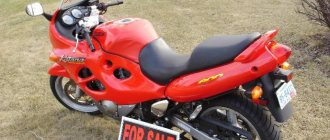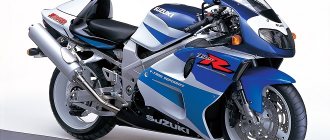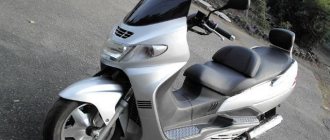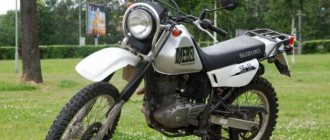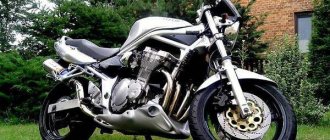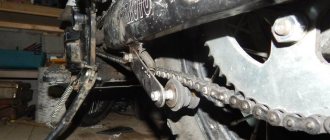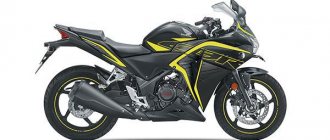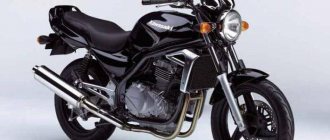The tenacious and durable enduro Suzuki DRZ 400 is well known to those who like to ride off-road on two wheels. This motorcycle has been produced in different versions since 2000 , and many copies of this model travel on Russian roads. In Europe, the bike has not been officially sold for a long time, since it does not comply with strict environmental standards of the European Union, but used copies in Russia and the CIS countries in 99% of cases come directly from Japan. And in its class, DRZ can be called one of the best!
000_moto_1011_044
Suzuki DR-Z400: enduro, 1999-present, 398 cm³, 40 hp, 130,000–320,000 rub.
Suzuki DR-Z400: enduro, 1999-present, 398 cm³, 40 hp, 130,000–320,000 rub.
STORY. Suzuki DR-Z400S was presented to the public back in 1999 as a natural development of the DR350 model, and already in 2000 it was recognized as the best among dual-purpose motorcycles. By 2002, it was equipped with adjustable suspension from the off-road version "E", which finally consolidated the dominant position of the DR-Z400S in its segment.
The DR-Z400 (only with a kickstarter) and the DR-Z400E (which received an electric starter), which appeared at the same time in the Suzuki product line, always stood apart: they were not intended for use on public roads, therefore they occupied their own sports and physical education niche and were not among the bestsellers. However, the main difference with the DR-Z400/E is that it has 9 hp more. (and this is 22.5%!) The engine power did not give (and still does) the owners of “legal” road “holes”. It was possible to “remove” 49 “horses” from the same 398 cubic meters thanks, mainly, to different camshafts and a slide-type carburetor (popularly known as “flat throttle”), so the first method of effective tuning of the DR-Z400S/SM engine was suggested by the manufacturer himself .
In 2005, the DR-Z400SM was born in response to the market's desire for a "factory supermotard". It is noteworthy that when building the SM version, Suzuki designers did not save money, limiting themselves to a minimal set of changes: in addition to the 17-inch wheels required for a motard (by the way, not just any wheels, but Excel!), shod with road tires, and a more powerful front brake , the rear suspension of the DR-Z400SM received a pendulum of variable cross-section, and in front there was a serious “reversal” from Showa with stays with a diameter of 47 mm, borrowed from the RM cross-country series. By 2007, instead of a steel 22mm steering wheel with a jumper, the SM acquired an “adult” aluminum “fatbar” from Renthal and received front and rear axle sliders.
In addition, during the “strategic partnership” of the Suzuki and Kawasaki corporations that caused a lot of noise in its time, the latter produced the KLX400 model, which is essentially the same DR-Z400, with the exception of plastic parts and a number of accessories. So don’t be surprised if you suddenly meet “Suzu” under the guise of “Kava”.
The domestic Japanese versions also have their own specifics: firstly, their head optics are noticeably smaller and, accordingly, have worse illumination, and secondly, the height of the saddle is somewhat less... due to its thickness.
And one more thing: despite popular belief that production of the DR-Z400 was discontinued in 2010, both the S and SM versions are still produced by Suzuki Manufacturing of America Corporation in the USA. Therefore, the “holes” of a 2011 model are quite real. It’s just that there was no way to bring the carburetor engine into compliance with the new European environmental standards, so the prudent Japanese stopped supplying “dirzets” to Europe. And at the same time to Russia, despite the fact that these standards for motorcycles have not yet been introduced in Russia.
Design
Who said "design"? For harsh enduro, this concept does not exist; the emphasis is not on a pretty appearance, but on reliability, power and the ability to overcome mud in which an Abrams tank can easily get stuck. Japanese designers hired by Suzuki think so, otherwise there is no way to explain why the Suzuki DRZ 400 looks almost indistinguishable from other enduros. And the off-road version differs visually from the SM version (supermoto, that is, motard) only in the wheels. But such motorcycles are loved not for their design, but for what they are capable of.
003_moto_1011_044
1999: Suzuki DR-Z400, DR-Z400E, DR-Z400S.
The new family of dual-purpose motorcycles from Suzuki was received with a bang by the public. The S-version, which is approved for use on public roads, has gained particular popularity. 1999: Suzuki DR-Z400, DR-Z400E, DR-Z400S. The new family of dual-purpose motorcycles from Suzuki was received with a bang by the public. The S-version, which is approved for use on public roads, has gained particular popularity.
Advantages and disadvantages
The Suzuki DRZ has enough advantages - the bike is perfectly balanced in all respects. Reliable, durable, hardy - whatever epithets they give it! But they are all rightfully deserved. Disadvantages are most often quite subjective.
Advantages
- Impressive acceleration dynamics and high top speed.
- Excellent long-travel suspension , excellent shock absorption. A full set of adjustments is included.
- Simple design . Any more or less experienced biker can repair or service the Suzuki DRZ on his own.
- Low cost of maintenance.
Flaws
- Weak traction at the bottom . To achieve good dynamics, the Suzuki DRZ engine must be “twisted”.
- A small gas tank coupled with high fuel consumption off-road.
- Due to the significant seat height, short riders may find it difficult to reach the ground with their feet.
- At high speeds, the Suzuki DRZ engine “eats up” oil . At the same time, due to the design features, oil starvation is deadly for it, so you need to monitor the oil level.
006_moto_1011_044
2007: Suzuki DR-Z400SM.
The motorcycle received a “thick” steering wheel and sliders on the front and rear axles. 2007: Suzuki DR-Z400SM. The motorcycle received a “thick” steering wheel and sliders on the front and rear axles.
FOR WHAT? The choice of a specific version of the Suzuki DR-Z400 is determined by the goals and objectives that are set for the motorcycle. So…
DR-Z400/E is a purely sports equipment that is not certified for use on public roads and, accordingly, was supplied to Russia without a title. Yes, there were individual “Eshki”, which, after screwing on the mirrors and sometimes even turn indicators, were imported as “just DR-Z400” and were equipped with a title, but this is the exception rather than the rule. Despite this, the motorcycle’s applicability is quite wide: from banal rides around the dacha and weekend trips to quite serious enduro competitions and rally raids at the Cup or Russian Championship level.
DR-Z400S is perhaps the most widespread representative of the DR-Z400 family. In fact, this is the material embodiment of the collective image of an unpretentious and reliable dual-purpose motorcycle, and practice readily confirms this. The DR-Z400S is a universal multi-purpose motorcycle on which you can equally successfully move around the city (and move very dynamically), carry a passenger, hone the basics of off-road driving (if not fanatical, then on a motocross track) and even ride long distances. Another important advantage of the DR-Z400 is its reliability. Of course, if you don’t forget about timely maintenance (which, according to the manufacturer’s recommendations, should be carried out with the same frequency as for most road motorcycles).
The supermotard DR-Z400SM is equally good both as a city transport and as an “adrenaline generator” - it all depends on the desires and ambitions of the rider. And although “popular opinion” is confident that the “Dyrzet” lacks a motor, this motorcycle in capable hands is able to leave behind even charged liters in dense city traffic. And the excellent suspension and brakes (especially in combination with a very small mass) allow, without exaggeration, to work wonders in traffic, changing the direction of movement of the SM-ki almost with the power of thought. In addition, long-travel, energy-intensive suspensions will be a good help for those who like to go around a dead traffic jam, and no curbs or stairs will interfere with the implementation of their plans. But, of course, on deserted night streets or country roads the driver of the “Dyrzeta” will feel a little out of place, because even brave “basins” will overtake him.
Both the S- and SM-versions of the Dyrzet are distinguished by their enormous motor life, which, combined with a long service interval, allows these motorcycles to be used in normal daily transport. At the same time, despite its sporting roots, the DR-Z is distinguished by good lighting technology, a fairly comfortable seat (by the standards of its class, of course) and even the presence of passenger footrests.
Nevertheless, the comfort of a motorcycle of this class, especially on long trips, is a very relative concept. Even the perfect energy capacity of the suspensions does not compensate for the hard palm-width seat and the complete lack of wind protection. But, for example, the author of these lines drove his DR-Z400SM from Murmansk to Moscow through Kirishi (which is almost 2000 km) in one sitting, and without any negative feelings. Except, perhaps, the volume of the gas tank is too small for such promenades.
WHERE TO LOOK? Today there are no difficulties in finding a “hole”: there are many offers on the domestic market for used equipment. In addition, these motorcycles are imported to order from both the USA and Japan. The last year of production of the DR-Z400S/SM sold by officials was 2009; the E-series stopped being officially imported two years earlier.
TUNING. It is quite natural that such a long-liver on the market as the DR-Z400 was not deprived of attention: the choice of components from third-party brands gives the owner of any version of the “dirzeta” unprecedented scope for creativity, starting from banal styling and ending with the construction of serious sports vehicles with a larger engine , than initially, the working volume.
Engine . The insufficient power of the DR-Z400S/SM engine has already become the talk of the town: not everyone is satisfied with its not quite, to put it mildly, sportbike-like dynamics. This can be corrected in various ways, starting with the classic installation of a direct-flow exhaust, increasing the flow area of the air intake and installing the appropriate DinoJet in the carb, and ending with the construction of an actually new motor of a larger displacement on the basis of the existing crankcase by increasing the cylinder diameter, piston stroke, or both. and another. There are kits on the market that allow you to achieve both small and significant changes in the displacement (and geometry) of the engine. For example, replacing the cylinder-piston group with a kit from Athena, JE Pistons or MaxRPMs will allow you to get a shorter stroke engine with a displacement of 435, 440, 450 or 455 cm3, replacing the crankshaft, connecting rod and piston with tuning ones from HotRods or MaxRPMs will result in a longer stroke engine with a displacement 430 or 440 cm3, and the combination of increasing the cylinder diameter and piston stroke simultaneously using Big Bore & Stroker kits from HotRods, MaxRPMs or Falicon will increase the displacement to 465, 480, 485, 493 and even 510 cm3. The only question is finances - the cost of top-end kits is around $1000–1200 in the USA.
Stars. The dynamic/traction characteristics of the motorcycle can be easily adjusted to the required conditions by changing the final drive ratio; the choice of leading and trailing stars is huge and will allow you to make an asphalt traveler, a trophy or stun vehicle out of the “hole”.
Kickstarter . During active off-road use of the DR-Z400S, installing a kickstarter on it is very popular; fortunately, a complete kit can be purchased in an American online store for $200–250. Or you can simply order the original kickstarter for version “E” (part number 26300–29813) through official dealers or “gray” spare parts suppliers; the manufacturer writes that this kick is only suitable for the DR-Z400E and is not intended for installation on the DR-Z400S, but the installation goes without problems, unless the decompressor parts remain unclaimed, since the cylinder head of the “esque” engine does not imply its presence.
Suspension. The main modifications to the “dirzeta” suspension are associated with a decrease in seat height. This is achieved by a fairly simple (and budget) method - replacing the original links of the rear suspension linkage system with links from Soupy's Performance or Kouba. These links come in different lengths, which, in fact, affects the degree of height reduction along the seat - for example, by 20, 32 and 45 mm in the case of links from Kouba. However, after this another difficulty arises - the length of the original side stand may turn out to be excessive and will need to be shortened. The price tag for a set of links usually fluctuates around $100 in the same US online stores.
Seat/Padding. Another way to make the DR-Z400 sit lower is to replace the seat. Also, replacing a seat can have another goal - increasing the level of comfort when riding a motorcycle. There are many offers on the market: seats from Corbin, Rick Mayer or Renazco Racing will cost $350–500 (and don’t forget to add shipping costs), you can save by ordering a seat from SDG for $150–200. There is also a more budget option - replacing only the padding and “skin” of the seat: Guts, FX, DIY offer various options, prices start at $75.
Frame covers. A very useful tuning element that allows you to keep the paintwork of the “hole” frame in the area of the pendulum mounting axis in its original form. Protective pads are recommended for all versions - both off-road and asphalt; There are aluminum, plastic and carbon fiber.
Crankcase protection. In principle, standard metal protection copes well with the hardships and hardships of off-road use, but if you are planning quite long expeditions, then you can play it safe. There are many crankcase protection offers on the market; These are mainly aluminum products that are much larger in area than the original protection, but there are also carbon ones, positioned primarily as protection for the SM version.
Fuel tank. Replacing the original tank (although here it would be more correct to say “tank”) with a tank of larger capacity helps to significantly increase autonomy. The manufacturers are well known - Acerbis, IMS, Safari Tanks (aka Aqualine), Clarke, you just need to decide on the required volume: a little more than the original one - 12-15 liters, more substantial - 17-18 liters. There are 28- and even 30-liter fuel storage facilities. Many manufacturers make tanks from translucent plastic, which is very convenient from the point of view of controlling the amount of fuel in the tank. Prices range from $300–700.
Dashboard. The native dashboard with many functions has two significant disadvantages. Firstly, it does not have a tachometer, and secondly, due to its rather small size, it can be damaged if dropped. Instrument panels for the DR-Z400 are made by TrailTech (Vapor line) and Koso. Moreover, the prices for them cannot be compared with those for native Suzuchi: a complete set, consisting of a dashboard, wiring, connectors and the necessary sensors, will cost $130–200 without delivery.
Wind protection. It is, of course, ridiculous to consider a tiny shield covering the “tidy” as wind protection. If long trips on highways are expected, then it makes sense to install a high wind deflector. There are few of them on the market, but there is still a choice. Prices range from $80 to $210. In addition to the wind shield, the protection of the levers is very useful (especially in rain and cold): hands hidden behind plastic “burdocks” freeze much less, and the levers do not cling to branches and are less likely to break when falling.
Wheel axle sliders. They are very useful during asphalt operation, as they help protect the front brake caliper and the lower parts of the fork legs when an abrasive substance falls on this surface.
PRICES. Prices for “dirzets” start from 130–140 thousand for motorcycles of the first years of production and reach 300–320 thousand for “official” devices from 2009 or motorcycles recently imported from the USA in 2010–2011.
Motorcycle price
Russian bikers do not often buy new motorcycles, preferring used ones supplied directly from Japan. Suzuki DRZ is not officially sold in Russia, so all copies come to us straight from the Land of the Rising Sun. The cost on the secondary market starts from 120-130 thousand for the oldest Suzuki DRZ, and can reach up to 400 thousand for fresh motorcycles in good technical condition. The Suzuki DRZ 400 SM is on average more expensive than its off-road counterparts in the model range.
014_moto_1011_044
CHOICE.
Engine. The engine has a huge resource. One of the problems is increased timing drive noise (a design feature), which appeared on motorcycles produced before 2007. Suzuki later corrected the defect by redesigning the timing chain tensioner.
Transmission. It is advisable to check how clearly the first gear is engaged, especially when it is hot. If you do not change the oil regularly, problems sometimes arise with this; Everything can be treated relatively inexpensively - from changing the oil at the initial stage to replacing a number of parts with a total cost of about 3,000 rubles.
Brakes. On the DR-Z400S they are sufficient, on the DR-Z400SM they are excellent. The only “but” is that if the SM is used excessively (during daily and prolonged stoppages), the guide bushings of the front brake disc break, causing disc play to appear. At the initial stage it is not critical, but it is still time to think about a replacement. In addition, if you try to install enduring wheels on the SM, you will have to leave the “asphalt” size brake disc, which may not be very useful on off-road conditions.
Air filter. Quite often there are motorcycles for sale on which the air filter has never been changed.
Suspension. As with any motorcycle that rides off the pavement at least occasionally, the rear suspension linkage system requires maintenance. In the absence of this, squeaks appear; At the initial stage, this is treated with cleaning and lubrication. The front fork on both the DR-Z400S and DR-Z400SM is practically indestructible if the stays do not have mechanical damage, which can be caused not only by falls, but also by the absence (on the SM “shifter”) of native protection of the stays.
| Estimated cost of consumables and spare parts Suzuki DR - Z 400 S / SM | ||
| Name | Original spare parts, rub. | Non-original spare parts, rub. |
| Oil filter | 400 | 320 |
| Brake pads (set) | 6800 | 1400 — 2400 |
| Set of stars | 5500 | 1800 — 2600 |
| Chain | 9500 | 2200 — 4500 |
| Lever protection | — | 3000 — 5000 |
| Reinforced brake hose (set) | — | 1800 |
| Wheel axle sliders | — | 2600 — 4000 |
COMPETITORS
Repair and tuning
Suzuki DRZ is reliable, and all tuning usually comes down to improving its already decent characteristics. There are plenty of offers on the Internet, but they will be of interest mainly to bikers who are well versed in the topic and know how exactly this or that part will be useful to them.
Repair
According to reviews, Suzuki DRZ rarely breaks down. It is distinguished by excellent durability, and even if it falls head over heels, it is unlikely that anything will fall off of it except the mirrors. Other breakdowns are most often caused by untimely maintenance, and they can be avoided if you take proper care of your two-wheeled friend.
Spare parts
Not everything is available, but this problem is familiar to all Russian bikers. You can find absolutely everything to order, from a clutch cable to an entire engine. Prices are comparable to those of 95% of other Japanese motorcycles.
Tuning
Often, owners of Suzuki DRZ equip the bike with protective cages, hand protection, install a lightweight exhaust system, or install other wheels .
Sometimes the suspension also changes, but this pleasure is not cheap. There is enough tuning for this model, but the price of individual components can be exorbitant.
Technical characteristics of Suzuki Off Road DR-Z400E
| Engine | |
| engine's type | 4-stroke, DOHC |
| Number and arrangement of cylinders | 1 |
| Number of valves | 4 |
| Working volume, cubic meters cm | 398 |
| Cylinder diameter, mm | 90,0 |
| Piston stroke, mm | 62,6 |
| Compression ratio | 12.2 : 1 |
| Supply system | Carburetor MIKUNI BSR36 |
| Lubrication system | Oil bath crankcase |
| Ignition system | Electronic |
| Cooling system | Liquid |
| Maximum engine power | 48 hp/35.3 kW at 9000 rpm. |
| Transmission | |
| Clutch | Multi-disc, oil bath |
| checkpoint | 5-speed |
| Drive unit | Chain #520 |
| Gear ratio of the main pair | |
| Weight and dimensions characteristics | |
| Length, mm | 2235 |
| Width, mm | 825 |
| Height, mm | 1235 |
| Wheelbase, mm | 1475 |
| Ground clearance, mm | 325 |
| Seat height, mm | 945 |
| Dry weight, kg | 119 |
| Fuel tank volume, l | 10 |
| Chassis | |
| Front suspension | Telescopic cartridge fork with a full range of adjustments: spring preload, compression damping (14-step) and rebound damping (18-step) |
| Suspension travel | |
| Rear suspension | Pendulum, monoshock absorber with a full range of adjustments: degree of spring preload, compression and rebound damping (separately for high and low suspension speeds) |
| Suspension travel | |
| Brake system | |
| Front | Hydraulic; disk |
| Rear | Hydraulic; disk |
| Tire size | |
| Front | 80/100-21 |
| Rear | 110/90-18 |
200912102002_scheme1
In the following days, DRZ saw Honey Falls, Bykogorka, a permafrost cave near Zheleznovodsk, the country's first hydroelectric power station (the same one where Ilyich's light bulb was lit) and other interesting places. On almost every ride, the DRZ400S allowed a rider with no enduro riding experience to go where it seemed impossible. The motorcycle crossed seemingly insurmountable obstacles easily and naturally, which is why we had to reconsider the concept of “impossible” more than once.
There were few shortcomings of the bike: a little too heavy for steep off-road conditions (especially when compared with the latest enduro and cross-country models), the center of gravity is located a little high, the light is weak, especially for the internal Japanese. There are many more strengths. “Zed” demonstrated decent dynamics, handling and good top speed, which is so lacking in many smaller cubic capacity enduros. City driving did not require the slightest stress; traffic jams and potholes caused only a slight smile. Even long-distance driving was possible on this motorcycle. However, the main strength of the Zed is its versatility, all-weather and all-climbability. A rare motorcycle will allow you to travel one and a half thousand kilometers on asphalt, leave this very asphalt wherever you please, and climb so far that you lose touch with reality.
Modifications
From the very beginning of production, the model was divided into 2 directions.
- Suzuki SV 400 is a classic naked bike . A round headlight, a steering wheel that allows you to sit in a classic manner, comfortable footrests.
- Suzuki SV 400S - version sport. Front fairing, windshield (low), double headlight in the tradition of sports bikes. Clip-ons are installed instead of the steering wheel, and the footpegs are also raised for a sporty style.
Suzuki SV 400S – front view.
Suzuki SV 400S – side view.
Suzuki SV 400S – rear view.
This was not included in the classic modifications, but upon order, the user could receive a tank of a different shape, allowing him to “lie down” on it.
200912102002_9
The next trip eclipsed all the previous ones. It began with an energetic “produbas” along a country road outside Kislovodsk and into the mountains. The road to the village of Kichi-Balyk was good, but higher up it became much more fun. And colder. The fun was provided by quality mud, water holes, occasional snow, and plenty of rocks. Despite these wonderful road conditions, the speed in some places reached 100–110 km/h. At times the bike was thrown mercilessly to the sides, but I always had enough control over the machine to avoid falling. The reason for this flexibility is the long-travel suspension and rigid frame. And, of course, tires. Despite the rounded “asphalt” profile and the flat surface of the “checkers”, it coped equally well with any kind of off-road conditions, did not fall “on its face” in the mud and managed to find traction on grass, shallow snow, loose surfaces and gravel. Of course, the T63 rubber did not provide the aggressive grip of a motocross tire, but it always provided just enough grip to continue the journey.
To reduce the discomfort caused by cold air, heated steering wheel grips came in handy. It's a shame that I didn't install them in Moscow; the 1600-kilometer road would have been much more pleasant.
The Shatjadmaz plateau with the shining domes of the mountain astronomical station appeared on the horizon. The solar observatory is one of the most beautiful, interesting and mysterious places in the surrounding mountains. It evokes a feeling of loss of reality, as if through a fantastic space-time portal you find yourself in a parallel universe, another world that exists simultaneously with ours and has contact with it only in this place on the planet.
The headlight “inside the Japanese” is lighter, but not as bright as that of the “European”.
The headlight “inside the Japanese” is lighter, but not as bright as that of the “European”.
The headlight “inside the Japanese” is lighter, but not as bright as that of the “European”.
The DRZ saddle is quite narrow, the comfort is minimal. In addition, the “draZina” turned out to be domestically Japanese, equipped with a seat of lower height** and thickness. The claims of the “fifth point” are quite understandable, but, alas, they have no choice. Let him endure and preferably silently dream about Corbin products...
Somewhere outside of Voronezh the asphalt ran out and lengthy road work began. It was here that I, a seasoned sport biker and a “near-zero” endurast, first got an idea of what a motorcycle was capable of. The cars crawled at a speed of 15–20 kilometers per hour. I easily hit 90. Amazing! I got to Rostov around 10 at night, spent the night and in the morning was serviced by Sasha the Modelist***. I had a nice bite of pike perch fish soup and then hit the road again. Around six I entered Mineralnye Vody.
Before the first trip off the asphalt, I replaced the stock Bridgestone with more “toothy” Michelin T63 tires (almost an ideal compromise of on-road and off-road qualities ****). In addition, I installed protection for the clutch and front brake handles, engine protection and heated steering wheel grips. And for ease of movement on the “humus” I removed the rubber inserts of the footrests.
200912102002_8
The feeling of unreality intensified when I descended from the plateau to Malka. Narzan springs are scattered along the river bank, the water of which is rich in iron salts. Because of this, the stones and earth around the springs are colored red-red. The taste of narzan turned out to be rather “metallic”, but pleasant. A strange analogy came to mind: uranium salts are also red (in my opinion, I read somewhere that for this reason one of the cities was named Krasnokamensk). And a metallic taste in the mouth is due to an overdose of radiation...
Having driven away the radioactive obsession, he moved further along the river bank. The landscapes that opened up to his eyes in the next half hour finally finished off the last drops of reason, and a fantastic world took possession of him. Rusty fir cones, abandoned villages, dilapidated walls of houses with inscriptions, some of them were more than half a century old, the view of the Caucasus Range and Elbrus - all this caused a feeling of absolute “surreal”. The day ended with a thermonuclear sunset...
200912102002_7
After the fact, I can say: if I had known the depth of that puddle, I would never have climbed into it. But I didn't know the depth. A meter from the edge of the puddle, Z dived sharply, the water rose to the gas tank. A thought flashed through my head: “I’ll get stuck, get up, stall and shamefully drown the bike.” But DRZ had his own opinion on this matter. Yes, the motorcycle began to slip, but at the same time it not only did not stop or stall, but also moved forward very confidently. Seconds later, the bike emerged from the slush like a submarine in emergency ascent mode.
Flew to the uranium mine in a matter of minutes. The entrance turned out to be closed with reinforced concrete slabs, fastened together by a massive channel, decorated with a “radiation hazard” sign and the autographs of local pithecanthropes. At the top of the blank concrete wall there were several ventilation holes, from which the wind blew in a steady stream. I sucked in a breath.
At first, the breathing of the uranium mine seemed like an ordinary draft. But a second later I felt cold, damp and the smell of rusting metal. It immediately dawned on me: in addition to the smells from the ventilation duct, as a bonus I receive a “life-giving” inhalation of alpha, beta particles and gamma quanta - products of the radioactive decay of uranium and related isotopes. He brought a dosimeter with Lermontov’s name “Bella” to the hole. The rare squeaking immediately merged into an almost continuous hysterical squeak. When the device finished counting, the display showed five times the natural background radiation rate. I decided not to stay long at the mine. I don’t know what dose I got, but I’ll probably skip fluorography this year.
200912102002_6
Another discovery in the field of DRZ capabilities was made during a trip to Mount Snake in the company of local friends. The funny thing is that up to about half the height the mountain is covered with grass and forest, and above it is almost devoid of vegetation and looks like a huge quarry. At the very beginning of the climb, when I had to cross hills with steep grassy slopes, I hesitated. The slope looked like 40 degrees, tall grass, half-road tires and a complete lack of hillclimbing experience - all this taken together made me stop dead in my tracks at the very foot.
The brain firmly pronounced its verdict: “You can’t go there, there’s pain and shame.” But the friends had already rushed to the top and were bored while waiting for the indecisive sport biker. There was nothing to do - without any acceleration I went to storm the heights. Contrary to the worst expectations, the motorcycle overcame the climb with incredible ease and almost without slipping or tearing off the front wheel.
The proven DR-Z400 engine has remained unchanged for many years.
The proven DR-Z400 engine has remained unchanged for many years.
The proven DR-Z400 engine has remained unchanged for many years.
The first off-road test of the motorcycle was a trip to Beshtau. In Tatar “Pesh Tau” means “Five Mountains”. In honor of this mountain, the nearby city was named Pyatigorsk. Another reason for Beshtau’s fame is the uranium mines, which in the past were developed, as the song went, by “ordinary Soviet prisoners.” I rushed to one of these mines.
Having flown at a high pace along the broken dirt road leading to the mountain, I entered the ring road encircling the mountain. After three hundred meters we encountered the first obstacle. A high-quality and rather large puddle spilled across the width of the entire road. You can't go around on the left - there's a sheer cliff. On the right is also not an option - a cliff.
The DR-Z400's electronic instrument cluster boasts many useful features.
The DR-Z400's electronic instrument cluster boasts many useful features.
The DR-Z400's electronic instrument cluster boasts many useful features.
The first refueling showed that the motorbike traveled 130 km to the reserve. The range is not outstanding. But the DRZ “feeds” on 92nd gasoline. Compared to many modern enduros from other manufacturers that require a 95, this is a big plus. After all, it is not always possible to find a more or less decent gas station in the middle of nowhere. I noted the convenient and functional tidy. In addition to the usual trip meters, clock and odometer, there is a timer, stopwatch and the ability to calibrate the odometer for extremely accurate distance measurements.
I was pleased with the “maximum speed” - exactly 150 km/h. But you can’t call it comfortable. If you grip the handlebars a little tighter than a songbird, the bike immediately responds to the rider's tension with a smooth shimmy. I slow down the speed to 130, and the Z's behavior returns to normal. The engine purrs steadily and the wind doesn’t bother you. Bliss. But it is at this moment that the “South Pole” issues a note of protest.
